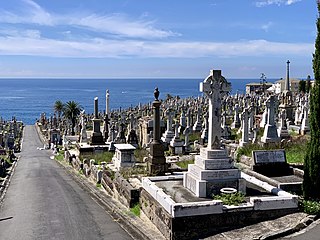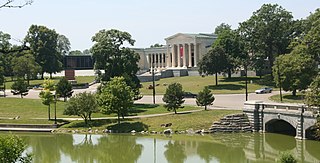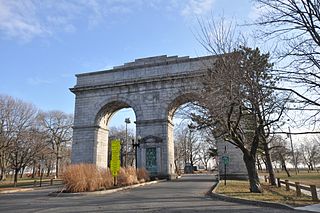
Frederick Law Olmsted was an American landscape architect, journalist, social critic, and public administrator. He is considered to be the father of landscape architecture in the United States. Olmsted was famous for co-designing many well-known urban parks with his partner Calvert Vaux. Olmsted and Vaux's first project was New York's Central Park, which led to many other urban park designs, including Prospect Park in Brooklyn and Cadwalader Park in Trenton, New Jersey. He headed the preeminent landscape architecture and planning consultancy of late 19th century United States, which was carried on and expanded by his sons, Frederick Jr. and John C., under the name Olmsted Brothers.

The Waverley Cemetery is a heritage-listed cemetery on top of the cliffs at Bronte in the eastern suburbs of Sydney, New South Wales, Australia. Opened in 1877 and built by R. Watkins and P. Beddie, the cemetery is noted for its largely intact Victorian and Edwardian monuments. It is regularly cited as being one of the most beautiful cemeteries in the world. The cemetery contains the graves of many significant Australians including the poet Henry Lawson. Also known as General Cemetery Waverley, it was added to the New South Wales State Heritage Register on 28 October 2016.

Calvert Vaux FAIA was an English-American architect and landscape designer, best known as the co-designer, along with his protégé and junior partner Frederick Law Olmsted, of what would become New York City's Central Park.

Malbone is one of the oldest mansions in Newport, Rhode Island. The original mid-18th century estate was the country residence of Col. Godfrey Malbone of Virginia and Connecticut. The main house burned down during a dinner party in 1766 and the remaining structure sat dormant for many years until New York lawyer Jonathan Prescott Hall built a new roughly 5,800 sq ft (540 m2) castellated residence directly on top of the old ivy-covered ruins.

Laurel Hill Cemetery, also called Laurel Hill East to distinguish it from the affiliated West Laurel Hill Cemetery in Bala Cynwyd, is a historic rural cemetery in the East Falls neighborhood of Philadelphia. Founded in 1836, it was the second major rural cemetery in the United States after Mount Auburn Cemetery in Boston, Massachusetts.

Many of the public parks and parkways system of Buffalo, New York were originally designed by Frederick Law Olmsted and Calvert Vaux between 1868 and 1896. They were inspired in large part by the parkland, boulevards, and squares of Paris, France. They include the parks, parkways and circles within the Cazenovia Park–South Park System and Delaware Park–Front Park System, both listed on the National Register of Historic Places and maintained by the Buffalo Olmsted Parks Conservancy.

Eustatia is a brick house overlooking the Hudson River in Beacon, New York, United States. Located on Monell Place in the northwestern corner of the city, it is a rare survival in Beacon of a cottage in the High Victorian Gothic style.
Francis ("Frank") R. Kowsky is a notable architectural historian and State University of New York (SUNY) Distinguished Professor of Fine Arts at Buffalo State College, SUNY, Buffalo, New York. He has published on nineteenth-century American architects and architecture including Frederick Withers, Calvert Vaux, and H. H. Richardson, as well as the architecture and landscape of Buffalo and northwestern New York State. He is also active in historic preservation and has served on the New York State Board for Historic Preservation, the Board of Directors of the Preservation Coalition of Erie County, New York, and is currently a trustee of the National Association for Olmsted Parks.

The Riverside Historic District, also known as Riverside Landscape Architecture District, encompasses what is arguably one of the first planned suburbs in the United States. The district encompasses the majority of the village of Riverside, Illinois, a suburb just west of Chicago. It was planned and designed by Calvert Vaux and Frederick Law Olmsted and features a number of architecturally distinguished buildings.

Ammadelle is a historic house at 637 North Lamar Boulevard in Oxford, Mississippi. Built in 1859, it is an Italianate mansion designed by Calvert Vaux, which he regarded as one of his finest works. It was designated a National Historic Landmark in 1974.

Kennedy Park is a 57-acre (23 ha) historic park located in Fall River, Massachusetts. It is bounded by South Main Street, Bradford Avenue, Middle, and Bay Streets in the southern part of the city. The area of the city where the park is located was until 1862, part of Rhode Island.

The Gallaudet College Historic District is a National Historic Landmark District encompassing the historic early campus of Gallaudet University in Washington, D.C. Gallaudet is the first school of higher education to be devoted to the education of the deaf and hard of hearing. Its campus was planned by Frederick Law Olmsted and Calvert Vaux, and its Gothic buildings were designed by Frederick C. Withers. The main Gallaudet College building was listed on the National Register of Historic Places in 1966 and designated a National Historic Landmark in 1965. The landmarked area was increased to cover the southern part of the campus, and was renamed as a historic district in 1974.

Martin Luther King Jr. Park, originally The Parade and after 1896, Humboldt Park, is a historic park located in Buffalo in Erie County, New York. The park is located in east Buffalo and bisected by Fillmore Avenue.

Machpelah Cemetery is located on North Street in Le Roy, New York, United States. It was opened in the mid-19th century and expanded since then. Graves from other, smaller burial grounds around Le Roy have been added. It was listed on the National Register of Historic Places in 2007, one of two cemeteries in Genesee County with that distinction.

The Architecture of Buffalo, New York, particularly the buildings constructed between the American Civil War and the Great Depression, is said to have created a new, distinctly American form of architecture and to have influenced design throughout the world.

Seaside Park, located in Bridgeport, Connecticut, is a 2.5-mile (4.0 km) long crescent-shaped park bordering Bridgeport Harbor, Long Island Sound, and Black Rock Harbor. The park lies within Bridgeport's South End neighborhood.

Fort Greene Historic District is a national historic district in Fort Greene, Brooklyn, New York, New York. It consists of 1,158 contributing buildings, two contributing sites, one contributing object, and two contributing structures. It is characterized by a concentration of architecturally distinguished three and four story townhouses developed speculatively and built between 1840 and 1890. Most are faced in sandstone and exhibit characteristics of the Greek Revival, Italianate, Second Empire, and Neo-Grec styles. It includes the 33-acre Fort Greene Park designed by Frederick Law Olmsted and Calvert Vaux in 1868. In the park is a column memorializing Revolutionary War soldiers that was designed by McKim, Mead, and White and erected in 1908. The park was built on the site of fortifications built in 1776 and 1814. Also located in the district is the Brooklyn Academy of Music.

Walnut Hill Park is a large public park west of downtown New Britain, Connecticut. Developed beginning in the 1860s, it is an early work of landscape architect Frederick Law Olmsted, with winding lanes, a band shell, and the city's monument to its World War I soldiers. The park was listed on the National Register of Historic Places in 1982.

The West End Historic District encompasses a predominantly residential area west of downtown New Britain, Connecticut. Forming a rough C shape around the west part of Walnut Hill Park, the area was developed in the late 19th century as one of its premier upper-class neighborhoods, home to business and civic leaders, with a fine array of late 19th and early 20th century architecture. It was listed on the National Register of Historic Places in 1998.

The Beth Olam Cemetery is a historic cemetery in Cypress Hills, Brooklyn, New York, United States. It is located in the city's Cemetery Belt, bisected by the border between Brooklyn and Queens.






















